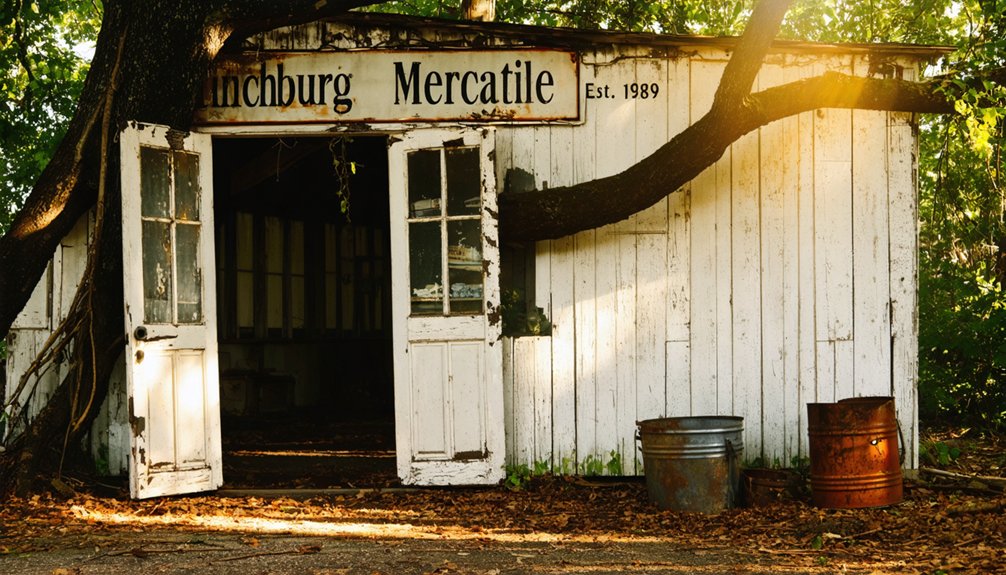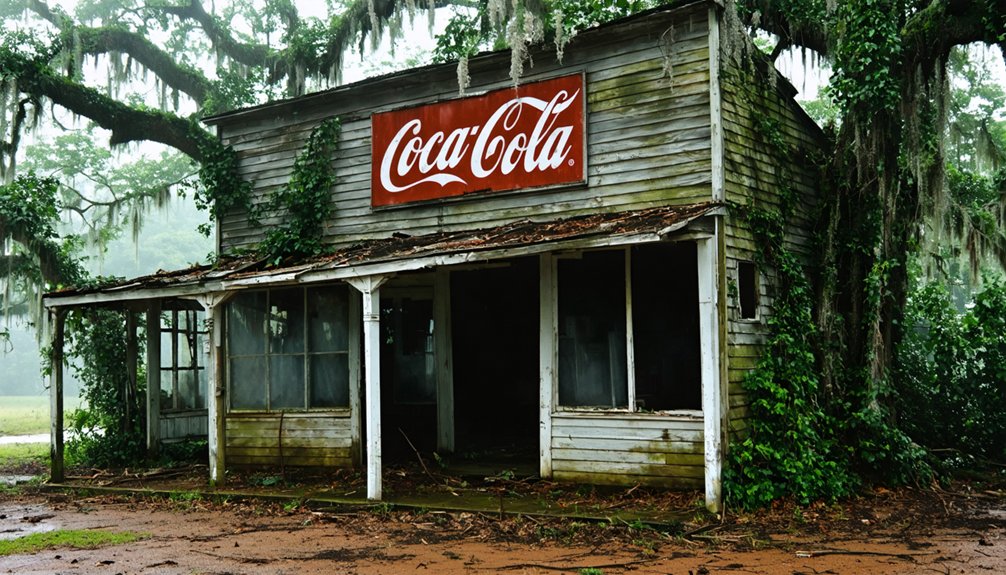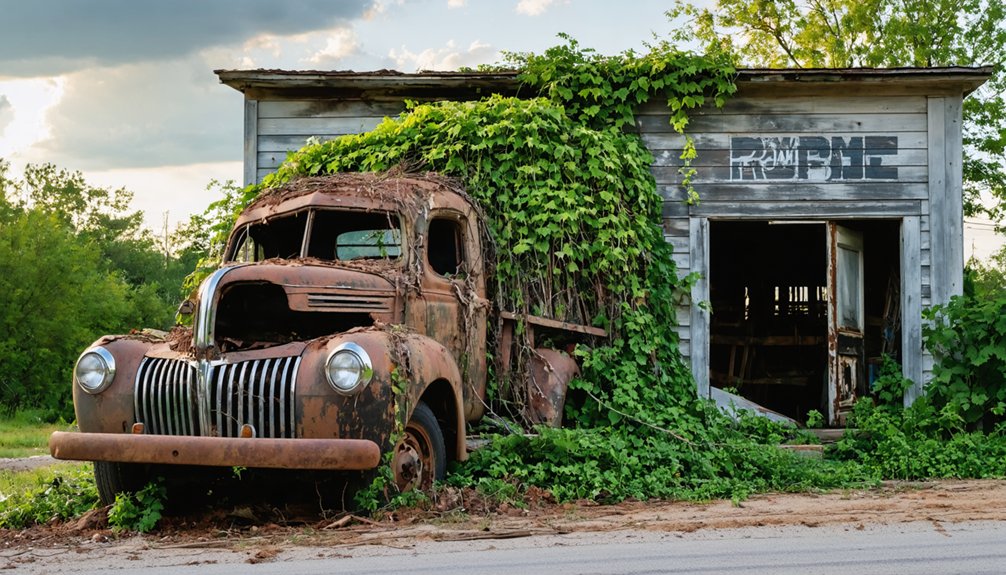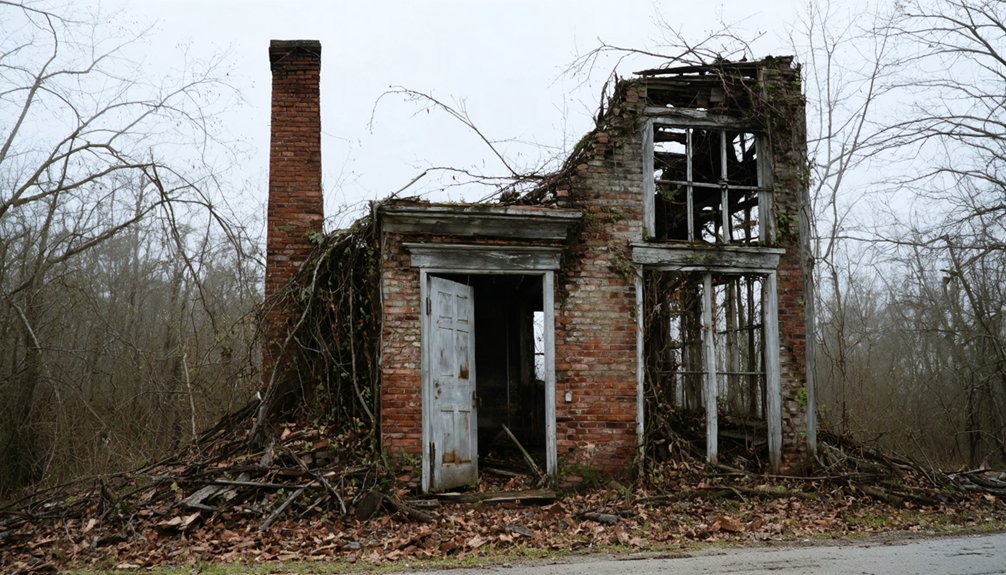You’ll find Finchburg’s ghostly remains at 31°38′34″N 87°30′39″W in Monroe County, Alabama, where abandoned railroad tunnels and decaying river docks mark what was once a thriving 19th-century cotton trading center. The town flourished through plantation agriculture and river commerce until economic decline, Yellow Fever outbreaks, and flooding drove residents away in the late 1800s. While few visible traces remain today, the site holds untold stories beneath its overgrown landscape.
Key Takeaways
- Finchburg was a 19th-century Alabama town built on Creek Indian land that thrived through cotton production and trade along strategic transportation routes.
- The town’s economy centered around cotton plantations, with wealthy landowners operating through enslaved labor and showcasing wealth in Federal-style homes.
- Economic decline began in the late 1800s due to industry relocations, bank failures, Civil War impacts, Yellow Fever outbreaks, and flooding.
- The site became a ghost town with only abandoned railroad tunnels, decaying river docks, and overgrown roadways remaining as evidence.
- Archaeological potential remains largely unexplored, with possible foundation ruins and artifacts hidden beneath vegetation throughout the former settlement.
Origins and Early Settlement
While the Creek Indians originally inhabited the lands that would become Finchburg, European-American settlers established this Monroe County community during the early to mid-19th century.
You’ll find this settlement nestled at 31°38′34″N 87°30′39″W, where early settlers claimed the fertile soil following the Creek’s displacement after the Battle of Horseshoe Bend and subsequent treaties.
Like nearby cotton gins at Claiborne, Finchburg’s economy relied heavily on cotton processing and trade during its early development.
As families moved in from eastern states, they shaped Finchburg’s identity through agricultural practices, primarily cotton farming.
The community’s strategic position near transportation routes supported trade and commerce, while local institutions emerged to serve the growing population.
Similar to the thriving town of Capps in its heyday, Finchburg served as a vital shipping point for agricultural products from the surrounding farmlands.
The Lee family, among other prominent settlers, helped establish the social framework that would define this rural Alabama settlement, reflecting the typical patterns of antebellum southern communities.
Life in Antebellum Finchburg
Sprawling cotton plantations dominated antebellum Finchburg’s landscape, where wealthy white landowners controlled vast agricultural operations through enslaved African American labor.
You’d find plantation culture on full display in grand Federal-style homes like the Dellet Plantation, with its imposing Doric porticos symbolizing the planter class’s wealth and power. The Masonic Lodge near Finchburg hosted many elite gatherings as the oldest public building in Alabama. These European-descended elites, mainly of English and Scots-Irish heritage, exercised complete social and political control through their positions in law, government, and civic institutions.
While white planters hosted elaborate social gatherings and religious ceremonies, enslaved communities endured harsh conditions in separate quarters, maintaining their cultural practices in secret. Many of these enslaved people were later relocated to plantations in Monroe County after being sold at regional slave markets.
The plantation economy thrived on forced labor, with top slaveholders owning dozens of people. This system persisted until the Civil War reshaped Finchburg’s social structure.
Impact of Regional Trade Routes
The strategic location of Finchburg within Monroe County’s network of historic trade routes helped shape its early development alongside the plantation economy.
You’d have found the settlement nestled near the intersection of crucial trade route dynamics, where the Great Pensacola Trading Path crossed the Old Federal Road near Burnt Corn. This economic connectivity meant you could easily transport cotton, corn, and timber downstream to markets in Mobile and Pensacola.
The Sepulga River complemented these overland paths, while springs and natural stopping points made crossroads essential for travelers. Local traders operated in coordinated pack groups to efficiently move goods through the region. The Creek Nation permission was required for anyone traveling through these territories before 1814.
When the Creek Wars erupted in 1813-1814, these trade corridors became strategic military pathways.
Factors Leading to Abandonment
If you’d traveled to Finchburg in the late 1800s, you’d have witnessed a town struggling against multiple crushing economic blows as its once-thriving industries shuttered and relocated to larger regional centers.
Similar to the fate of early Alabama towns along key waterways, Finchburg’s decline mirrored the pattern that would later impact settlements across the region.
Local banking institutions failed while essential services vanished, creating a domino effect that pushed both businesses and residents toward more prosperous Alabama cities.
Much like the tragic tale of Crazy Nancy’s ghost at nearby Nancy Mountain, which symbolizes loss and abandonment, the devastating impact of the Civil War, combined with deadly Yellow Fever outbreaks and the constant threat of flooding from nearby rivers, ultimately drove away the remaining population and sealed Finchburg’s fate as a ghost town.
Economic Shifts Impact Finchburg
Mining operations that once sustained Finchburg’s prosperity faltered dramatically during the 1930s, marking the beginning of the town’s economic decline.
You’d have witnessed profound economic transformations as gold and marble extraction became unprofitable during the Great Depression. The town’s community resilience was tested when miners left for California’s promising goldfields, while agricultural struggles, particularly in cotton production, further weakened the local economy. When state legislature relocated, the town lost additional opportunities and resources.
Much like nearby Cahawba which faced devastating flood damage in 1865, natural disasters exacerbated the town’s troubles. The Civil War’s aftermath dealt additional blows as Confederate forces redistributed crucial infrastructure, disrupting trade networks.
As residents departed, you’d have seen the gradual closure of essential services – schools, post offices, and administrative centers. These closures created a domino effect: fewer services led to more departures, accelerating Finchburg’s path toward abandonment.
Transportation Routes Change Forever
Once thriving as an essential river landing site, Finchburg’s fate took a decisive turn when major railroad developments bypassed the town entirely. The transportation evolution favored new routes, leaving Finchburg disconnected from the critical Louisville and Nashville Railroad corridors.
You’d have witnessed the town’s strategic importance fade as river commerce dwindled and modern road networks chose different paths.
- Abandoned railroad tunnels stand as silent reminders of bygone prosperity
- Former river landing docks slowly decay along the quieted waterfront
- Empty rail beds trace paths where freight cars once rumbled through
- Overgrown roadways lead to what was once a bustling transport hub
The railroad impact proved devastating – without access to main transportation arteries, Finchburg couldn’t sustain its community or commerce, ultimately sealing its destiny as a ghost town.
Historical Landmarks and Remains

Today’s visitors to Finchburg will find remarkably few traces of the former Alabama settlement, with most historical landmarks and structural remains having succumbed to time and nature.
You’ll discover that the town’s historical significance now lies primarily beneath the surface, with only subtle hints of its past visible in the landscape.
While exploring the area, you might spot remnants near the former river landing, where Finchburg’s residents once conducted trade along the Alabama River.
The archaeological potential of the site remains largely untapped, with possible foundation ruins and artifacts hidden beneath years of vegetation.
The post office that once served the community has vanished, leaving behind only scattered evidence of the town’s role in Monroe County’s development.
Unlike other ghost towns in Alabama, Finchburg’s physical heritage exists mainly in historical records.
Neighboring Ghost Towns of Monroe County
Throughout Monroe County’s rich history, several ghost towns have emerged alongside Finchburg, with Claiborne standing as the most prominent among them.
You’ll find Claiborne’s significance deeply rooted in its strategic location above the Alabama River, near the historic Federal Road. While ghost town documentation remains challenging for many Monroe County settlements, these abandoned places tell compelling stories of Alabama’s past.
- Perched high on river bluffs, Claiborne’s remaining structures whisper tales of antebellum prosperity.
- The mysterious Smith Settlement echoes with untold stories of early pioneers.
- Ventura’s forgotten pathways trace the footsteps of those who sought fortune.
- Hidden ruins scattered throughout the county reveal the impact of Civil War upheaval.
These silent witnesses to history stand as proof of the region’s ever-changing landscape and the resilient spirit of its early settlers.
Preserving Finchburg’s Legacy

As Monroe County’s heritage faces ongoing threats from time and development, dedicated efforts to preserve Finchburg’s legacy have emerged through multiple channels.
You’ll find community engagement initiatives taking shape through local museums, foundations, and volunteer programs that protect the ghost town’s physical remains and cultural memory. Preservation techniques include mapping historic trails, documenting structures through 3D scanning, and stabilizing existing ruins.
You can explore Finchburg’s history through educational programs, guided tours, and digital archives that bring its past to life.
Local historians work alongside preservation societies to secure funding through grants and endowments, while partnerships with state parks help protect surrounding lands. These coordinated efforts guarantee that Finchburg’s stories and sites endure for future generations to discover.
Frequently Asked Questions
Are There Any Paranormal or Supernatural Stories Associated With Finchburg?
You won’t find documented ghost sightings or local legends tied to this location, as historical records don’t mention any supernatural activity – unlike other Alabama ghost towns that maintain rich paranormal traditions.
What Was the Peak Population of Finchburg During Its Most Prosperous Years?
You won’t find exact numbers for Finchburg’s peak, as historical records are incomplete. Like many small cotton-industry towns that experienced population decline, it likely housed several hundred residents at most.
Did Any Notable Historical Figures Ever Visit or Live in Finchburg?
You won’t find records of notable historical visits or prominent residents in Finchburg. Unlike nearby Claiborne, which attracted influential figures, there’s no documented evidence of any distinguished individuals spending time here.
Can Visitors Legally Explore the Finchburg Site Today?
You can’t legally explore without explicit landowner permission, as there aren’t established visitor guidelines or public access rights. The site remains private property protected by Alabama trespassing laws.
Were There Any Natural Disasters That Contributed to Finchburg’s Abandonment?
You’ll find nature’s impact on Finchburg’s abandonment isn’t well documented in historical records. While Alabama faced floods and tornadoes, there’s no confirmed disaster timeline specific to this town’s decline.
References
- https://digitalalabama.com/alabama-ghost-towns/alabama-ghost-towns/9449
- https://alabamaliving.coop/articles/old-claiborne-pilgrimage-offers-history-lesson-on-southwest-alabama/
- https://tarc.tufts.edu/about/news/Keeping History Alive (even when the towns are gone)
- https://digitalalabama.com/article/alabama-ghost-towns/page/3
- https://freepages.history.rootsweb.com/~gtusa/usa/al.htm
- https://en.wikipedia.org/wiki/List_of_ghost_towns_in_Alabama
- https://theweek.com/articles/515196/getting-flavor–alabama-ghost-town-more
- https://digitalalabama.com/article/alabama-ghosts-and-ghost-towns
- https://en.wikipedia.org/wiki/Finchburg
- https://en.wikipedia.org/wiki/Monroe_County



